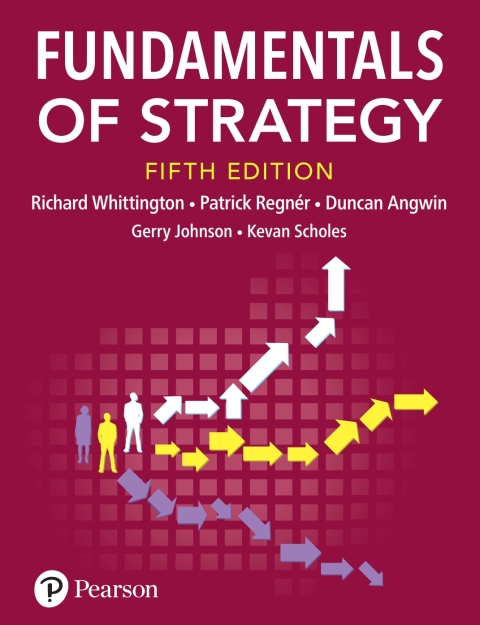Description
Efnisyfirlit
- About Fundamentals of Strategy
- Title Page
- Copyright Page
- Brief contents
- Contents
- Getting the most from Fundamentals of Strategy
- Fundamentals of Strategy Online
- 1 Introducing strategy
- 1.1 Introduction
- 1.2 What is strategy?
- 1.2.1 Defining strategy
- 1.2.2 The purpose of strategy: mission, vision, values and objectives
- 1.2.3 Strategy statements
- 1.2.4 Levels of strategy
- 1.3 The Exploring Strategy Framework
- 1.3.1 Strategic position
- 1.3.2 Strategic choices
- 1.3.3 Strategy in action
- 1.4 Strategy development process
- Summary
- Recommended key readings
- References
- Case example: The rise of a unicorn: Airbnb
- 2 Macro-environment analysis
- 2.1 Introduction
- 2.2 PESTEL analysis
- 2.2.1 Politics
- 2.2.2 Economics
- 2.2.3 Social
- 2.2.4 Technology
- 2.2.5 Ecological
- 2.2.6 Legal
- 2.3 Forecasting
- 2.3.1 Forecast approaches
- 2.3.2 Directions of change
- 2.4 Scenario analysis
- Summary
- Recommended key readings
- References
- Case example: Alibaba: the Yangtze River Crocodile
- 3 Industry and sector analysis
- 3.1 Introduction
- 3.2 Industry analysis
- 3.2.1 Defining the industry
- 3.2.2 The competitive forces
- 3.2.3 Complementors and network effects
- 3.2.4 Implications of the competitive five forces
- 3.3 Industry dynamics
- 3.3.1 The industry life cycle
- 3.3.2 Comparative industry structure analyses
- 3.4 Competitors and markets
- 3.4.1 Strategic groups
- 3.4.2 Market segments
- 3.5 Opportunities and threats
- Summary
- Recommended key readings
- References
- Case example: Game-changing forces and the global advertising industry
- 4 Resources and capabilities analysis
- 4.1 Introduction
- 4.2 Foundations of resources and capabilities
- 4.2.1 Resources and capabilities
- 4.2.2 Threshold and distinctive resources and capabilities
- 4.3 Distinctive resources and capabilities as a basis of competitive advantage
- 4.3.1 V – value of resources and capabilities
- 4.3.2 R – rarity
- 4.3.3 I – inimitability
- 4.3.4 O – organisational support
- 4.4 Analysing resources and capabilities
- 4.4.1 VRIO analysis
- 4.4.2 The value chain
- 4.4.3 SWOT
- 4.5 Dynamic capabalities
- Summary
- Recommended key readings
- References
- Case example: Rocket Internet – will the copycat be imitated?
- 5 Stakeholders and culture
- 5.1 Introduction
- 5.2 Stakeholders
- 5.2.1 Stakeholder groups
- 5.2.2 Stakeholder mapping
- 5.2.3 Owners
- 5.3 Corporate governance
- 5.4 Corporate social responsibility
- 5.5 Culture and strategy
- 5.5.1 Organisational culture
- 5.5.2 Analysing culture: the cultural web
- Summary
- Recommended key reading
- References
- Case example: Uber and the ubermensch
- 6 Business strategy and models
- 6.1 Introduction
- 6.2 Generic competitive strategies
- 6.2.1 Cost-leadership strategy
- 6.2.2 Differentiation strategy
- 6.2.3 Focus strategy
- 6.2.4 Hybrid strategy
- 6.3 Game theory
- 6.4 Business models
- 6.4.1 Value creation, configuration and capture
- 6.4.2 Business model patterns
- Summary
- Recommended key readings
- References
- Case example: The IKEA approach
- 7 Corporate strategy
- 7.1 Introduction
- 7.2 Strategy directions
- 7.2.1 Market penetration
- 7.2.2 Product and service development
- 7.2.3 Market development
- 7.2.4 Unrelated diversification
- 7.3 Diversification drivers
- 7.4 Vertical integration
- 7.4.1 Forward and backward integration
- 7.4.2 To integrate or to outsource?
- 7.5 Value creation and the corporate parent
- 7.5.1 Value-adding activities
- 7.6 The BCG (or growth/share) matrix
- 7.7 International diversification strategy
- 7.8 Growth methods: organic, acquisitions and alliances
- Summary
- Recommended key readings
- References
- Case example: Grand strategies in vision
- 8 Entrepreneurship and innovation
- 8.1 Introduction
- 8.2 Entrepreneurship
- 8.2.1 Opportunity recognition
- 8.2.2 Steps in the entrepreneurial process
- 8.2.3 Stages of entrepreneurial growth
- 8.3 Innovation dilemmas
- 8.3.1 Technology push or market pull
- 8.3.2 Product or process innovation
- 8.3.3 Open or closed innovation
- 8.4 Innovation diffusion
- 8.4.1 The pace of diffusion
- 8.4.2 The diffusion S-curve
- 8.5 Innovators and imitators
- 8.5.1 First-mover advantages and disadvantages
- 8.5.2 The incumbent’s response
- Summary
- Recommended key reading
- References
- Case example: Rovio’s Angry Birds: The evolution of a global entertainment empire
- 9 Strategy in action
- 9.1 Introduction
- 9.2 Structural types
- 9.2.1 The functional structure
- 9.2.2 The divisional structure
- 9.2.3 The matrix structure
- 9.2.4 Multinational/transnational structure
- 9.2.5 Project-based structures
- 9.3 Systems
- 9.3.1 Planning systems
- 9.3.2 Cultural systems
- 9.3.3 Performance targeting systems
- 9.3.4 Market systems
- 9.4 Strategic leadership
- 9.5 Types of strategic change
- 9.5.1 Adaptation
- 9.5.2 Reconstruction
- 9.5.3 Revolution
- 9.5.4 Evolution
- 9.6 Steps for strategic change: Kotter’s Change Model
- Summary
- Recommended key reading
- References
- Case example: Tencent: Third Time Lucky?
- Glossary
- Name index
- General index
- Publisher’s acknowledgements
- Back cover







Reviews
There are no reviews yet.